Kilin and Diz, two masterpieces
Kilin and Diz, two masterpieces
The Mole armchair was so bright that it overshadowed the recognition of other striking creations featuring amazing design solutions. Kilin, from 1973, and Diz, from 2001, are chairs experts considered masterpieces.
Named after Vera Beatriz, who Sergio affectionately called “little squirrel,” the Kilin armchair is many people’s favorite piece. With a bold design, forms and fittings made of shapely hardwood, leather floating in the air and made in such a manner as to shape and embrace the body, Kilin is one of Sergio’s most copied pieces. It was also among the most exported to the Nordic countries in the 1970s. Kilin was born from Sergio’s desire to make a less expensive, simpler armchair his friends could buy.
“Oca’s models were expensive, not because I wanted them to be, rather because the material was expensive, construction was expensive, they were hand-crafted and the skilled workers that built them were expensive. I was worried about not being able to sell to friends who could not afford it. So I created a company called Meia-Pataca, next to Oca. It sold furniture I had designed, but that were made with simple wood and were semi-serial. It was then possible to lower the price. That is how Kilin was born. Many people used to buy from the main store, Oca, while they would buy for their kids or for the cottage at Meia-Pataca.”
But Sergio also wanted a more affordable piece at Oca. He then imagined a wooden structure with two sides and two crossmember, a back and leather seat in one piece and less expensive for Kilin. The structure was made with crossmembers attached to the side with wedges. Sergio had already left Oca when Freddy van Camp, the store’s new designer, asked the crossmembers to be attached with Allen screws, which would simplify manufacturing, and they began to be packed in special cardboard boxes and exported.
Diz and Chifruda
Diz, made entirely out of wood, can be extremely comfortable even without any upholstery. It is one of Sergio’s most sought after pieces. But in its design, Diz is a little different from what is on the market. Sergio made the seat and backrest shells with 24 solid wood strips each and a trapezoidal section to form the curvature. The parts are glued using a mold and the piece is then machined. Each ruler is in the shape of a small cane with a curve at the tip to form the trim of the ends of the seat and backrest. He conceived the piece this way. Today, the seat and back of Diz are made with molded plywood using a large aluminum press, and it already comes out in that shape from the industrial manufacturing process. The original was more sophisticated.
To Adélia Borges, Diz is the synthesis of Sergio’s career. “It is amazing how he attained a phenomenal degree comfort in a chair using only wood to make it. It is the outcome of a mastery and a synthesis of what he learned over the years about the proper slope, arm support, etc. Diz innovates and, as he says, it is “hard” comfort as opposed to Mole (soft).”
Fernando Mendes says that when Sergio made the first Diz chair its feet were chubbier than the crossmembers. “It was more elaborate and handmade. It is not like that today. The sides join the feet and form a single plane. You glue it all, run it through the molding machine, make the profile and shape the contour. In all his work you can notice the possibility to simplify the design to meet the requirements of industrialization. The pieces are always fun and creative. It does not matter whether there is has a super joiner or a simple factory available. In the very simple Cuiabá construction, or in Oscar, with much more elaborate manufacturing, since its woodwork is more exquisite, one may note that none of them lost any expression or the looks of Sergio Rodrigues’ furniture.” The Oscar armchair – a tribute to Oscar Niemeyer – with a back and seat made of straw, wooden legs and arms, was commissioned by the Brazilian Jockey Club and refused by the customer for being “too modern.”
The Chifruda, which Sergio created in 1962 for the “Furniture as an Object of Art” show, which was held at Oca, was, according to Sergio himself, a joke “to show the technical capacity of leather and wood.” To him, “its leather craft was very good.” At the time, Chifruda was a scandal. “True creation, made with love, it is art,” he guaranteed.
Xibô
The Xibô armchair (a nickname Vera Beatriz gave Sergio, who called him that in private), meanwhile, is a project that had reached a standstill because they needed to determine what to do with its upper part. “There was always an obstacle in this project,” said Fernando, who helped Sergio, adding some details in a perspective of Xibô. “Sergio them made a little line, defining the outline of the head and the project was finally resolved. He made a simple free hand line that brought the answer he took twenty years to find,” remarked Fernando. “I made the entire prototype, but Sergio still wanted to add the traditional holes of his pieces. We were going to make the wooden headboard, but with its sharp bend, the piece would be weak at its tips. We developed it and made the piece out of molded plywood. Sergio was not happy with the way the edges of the plywood looked. So we decided to coat the plywood with leather while maintaining the holes at the tips. It was the upholstery man who saved us, as he made the leather lining using the same stitching technique used for car steering wheels to finish off the holes in the headboard. With all these comings and goings we were able to close the Xibô project.”
Tonico
The Tonico armchair, created in the same period as Chifruda, was a piece of furniture designed to offer the same comfort as Mole, but to be easier to make and could be used in student housing. Tonico chairs were sold especially to people who owned cottages, vacation homes, and beach houses. “It was not only to meet the needs of people with fewer financial resources, but to offer the simplicity and top comfort those drawings could provide. I called it Tonico to honor my brother in law. He fell in love with the chair. He had no taste at all. He sat in it and said: ‘I want nothing else, only this. This is beautiful.’ I mean, he already thought the chair was beautiful, had great aesthetic quality, and considered it good and comfortable. So I gave it his name: Tonico. The names are almost always connected to things in the workplace, to the customer.”
Gio and Vronka
Sergio made the Gio in honor of the Italian architect Gio Ponti, who a few years earlier had published an article on Sergio’s furniture in the famous magazine Domus. He made it in 1958 and, always with his sharp wit, thought students would start to respect him “a little more” because Gio Ponti was an important architect. Sergio then created Vronka, a reinterpretation of Gio.
“I had that in mind. I wanted to make a chair that could be used by some kids in the counterculture days. The chair had a seat that was hardly a seat. It was a wider piece that allowed one to keep a young person’s pose, in other words, sit cross-legged on the chair. It has a few pins on its side to allow the shell to move. It is the first piece that appears on my furniture with upholstery, as a coating. And then I found it curious because looking at the finished piece gives you the idea that it is highly complex, hard to make, but it is very simple. It was the influence of the furniture I had in my house, with classic knobs. There was a piece at Gio that came in and out of those shell holes that allowed the person to sit in other positions. And the fixed pad to support your head on and adjust.”
He already imagined manufacturing in his drawing
Sergio’s proximity to the manufacturing process of his furniture is striking in his career. Sergio was never a joiner, but had owned several factories and knew the machines well. When drawing his projects, he could already imagine how that piece of furniture would be manufactured. “I never saw Sergio make mistakes in this respect in his designs,” says the designer Fernando Mendes, who worked with Sergio for many years and is one of his professional heirs.
“I was able to keep pace with the evolution in Sergio’s eyes when he revisited his projects. He has done this with many pieces while debugging his work,” continues Fernando. “He did it with Diz, with Mole, with Mocho. After a while, his view on the piece matures and he moves away from the moment of creation. But at the time of production, there is also the interpretation of those who will manufacture it. This may be an evolution, but it can also be an involution. Sometimes the work is in the hands of the master carpenter, who may be more or less sensitive to interpret the drawing. Sergio never was overly severe fighting for his projects, demanding them to be exactly what drew. So sometimes they did not turn out exactly the way he wanted them to be. I always try to be faithful to the design.”
The Burton table
The observation of and fascination with objects that have always been in his life may have led Sergio develop this intimacy with the manufacturing of his products. In an interview with Afonso Luz, in July 2012, Sergio spoke of the impact this had in his creations, describing his furniture: “I had a passion for aviation and boating. I liked sailing, yachting. And I also used to like aviation, especially First World War Aviation because you can see the entire structure, which is nearly apparent and with special airfoils. I started making some furniture with those characteristics. That is how I designed the Burton table, for example. It started being made yet in 1957. And it was already made with crossmembers with those oval or aerodynamic sections. The feet were like airplane wing brackets, on bi-planes, also with the appropriate section. To me it was wonderful. And, to wrap it all up, since we were making its feet with small dots touching the table top, there was a need for a metal rod for balance. So there was a rod as well to stabilize it. That was a table that I liked a lot. And it was greatly appreciated the first day I put it in the store [at Oca].” The Burton table was made out of solid wood, with a solid table top and details made out of polished tin.
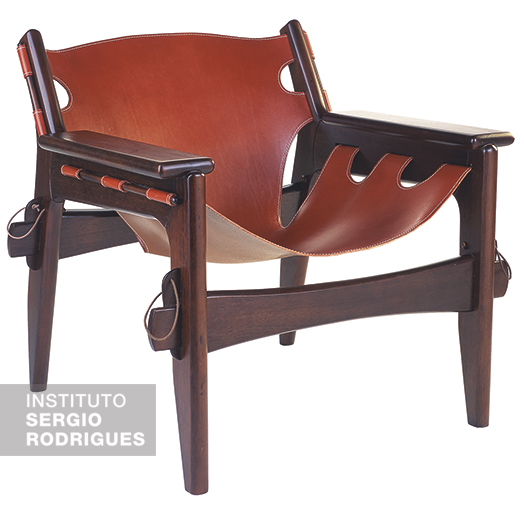
"Leve Kilin" armchair created by Sergio Rodrigues in 1973, made out of solid hardwood, one-piece back made of leather.
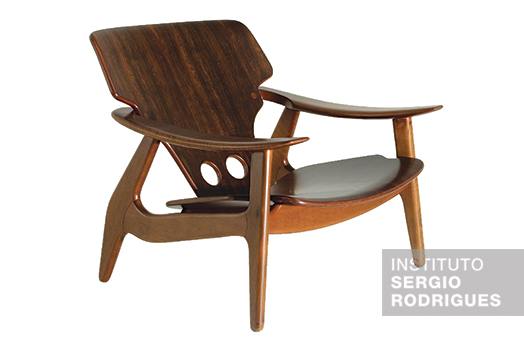
"Diz" armchair created by Sergio Rodrigues in 2001, made out of solid hardwood with a seat and back made out of hardboard.
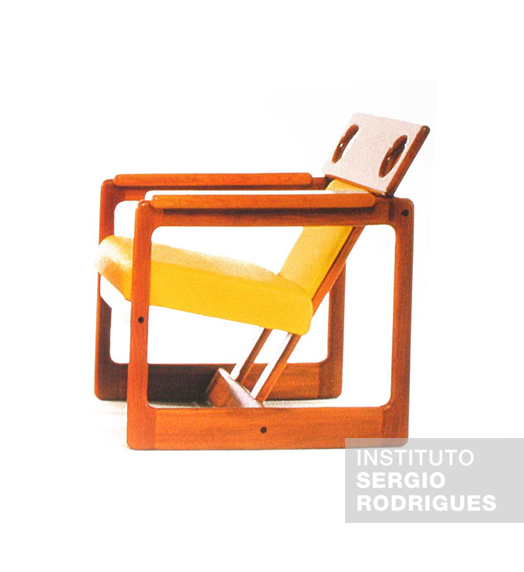
"Leve Cuiabá" armchair created by Sergio Rodrigues in 1985, made out of solid hardwood, a line for hotels or informal environments.
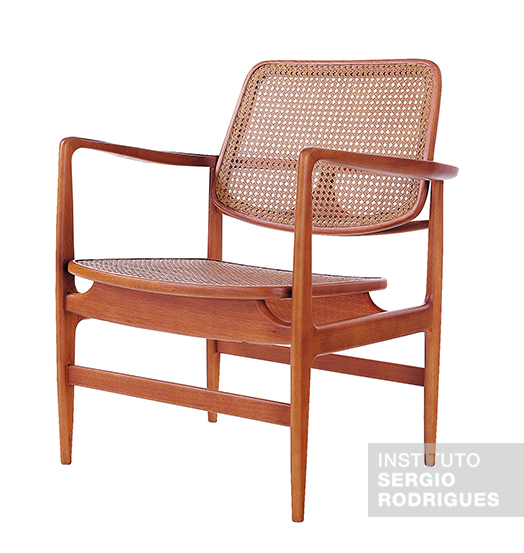
"Leve Oscar" armchair, created by Sergio Rodrigues in 1956, made out of solid hardwood.
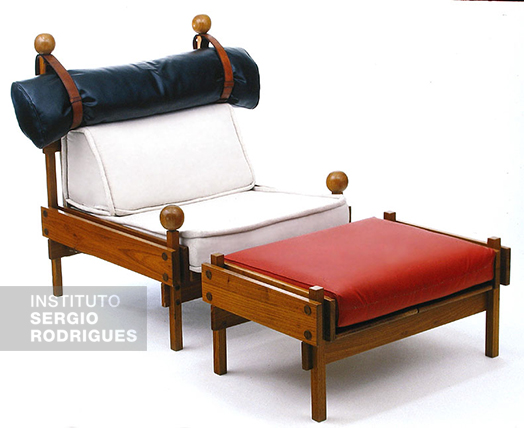
"Tonico" armchair, created by Sergio Rodrigues in 1963 for the Meia Pataca line and made out of solid hardwood.
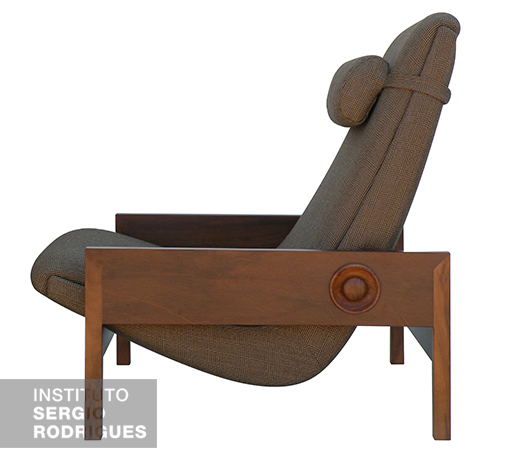
"Gio" armchair created by Sergio Rodrigues in 1958, made out of solid hardwood lined with fabric and polyurethane foam upholstery.

"Vronka" armchair, created by Sergio Rodrigues in 1962, with legs and arms made out of solid hardwood.
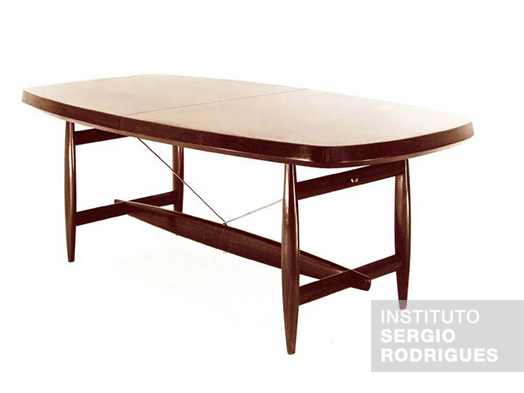
"Burton" table, created by Sergio Rodrigues in 1958, made out of solid hardwood.
